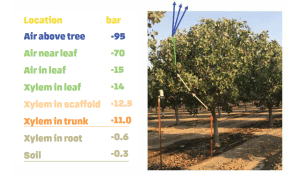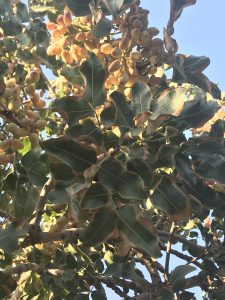
Pistachios are known for their drought adaptations and suitability for the hot, arid climate found throughout the Central Valley. However, even drought-tolerant pistachios need adequate water for growth and optimal production. Remarkably, pistachios, like other trees and vascular plants, retain only a small portion of the water they absorb from the soil. Roughly 90% passes through the tree and out the leaves into the atmosphere through a process called transpiration.
Water Loss Necessary for Plant Growth
Water (H2O) is not simply ‘lost’ by transpiration; it is a process that keeps canopy leaves cool during hot summer days and supports the ability of plants to perform their most vital function: photosynthesis. Photosynthesis is how plants make energy to support vegetative growth, and in the case of pistachios, nut production. Along with water, the process requires carbon dioxide (CO2) from the atmosphere and energy from sunlight. Plants absorb CO2 and lose water through the same small pores called ‘stomata’ (Figure 1) located on the upper and lower sides of leaves. However, much more H2O (nearly 400 molecules) is transpired for every one molecule of CO2 absorbed. This high rate of water loss is what creates the pull of water from the soil to the roots and through the xylem tissue within the trunk, canopy and leaves, and finally to the atmosphere (Figure 2, see page 8). The xylem tissue is a continuous system of long tube-like structures that maintain turgor and the continuous flow of water from the roots to all parts of the plant.

Trees Are Under Pressure
In any circumstance, water movement from one place to another always depends on a difference in potential energy, a measure expressed in units of pressure (‘bars’ or megapascals ‘MPa’) representing the amount of energy per unit volume of pure water. Within a tree, the potential energy of water containing solutes is always a negative number relative to pure water with a value of zero. That is not to say pure distilled water does not have energy. Pure water has the highest number of H2O molecules to move freely compared to H2O in the tree that has higher concentrations of solutes.
Water always moves spontaneously on a gradient from high water potential (less negative value) to low water potential (more negative value.) In an orchard, the moist soil has a higher water potential than the roots, which is greater than the trunk, scaffold, leaves and air surrounding the tree (Figure 2). Researchers have used the pressure chamber to identify the range of ‘baseline’ water potential values for a mature well-watered tree at midday, the warmest part of the day when trees are under the most water stress (anrcatalog.ucanr.edu/Details.aspx?itemNo=8503#FullDescription).
Midday stem water potential (MSWP) provides the status of the trunk xylem, considered the most consistent measure of water status within the tree. From an irrigation standpoint, understanding the MSWP for an orchard with reference to the ‘baseline’ can provide a means to determine when to apply water and when to hold off. For pistachio, trees in moist non-saline soil may have tree MSWP values between -9 and -12 bars. As the soil dries, mild stress develops between -12 and -15 bars, and values more negative than -18 bars risk severe stress. The baseline for trees in saline growing conditions will usually have more negative baseline values for which the range is currently under study by researchers.

How Water Stress Conditions Develop
Increasing air temperature, low atmospheric relative humidity and reduced soil water availability increase the tension gradient that drives the flow of water through trees. Plant water stress begins to develop when the rate of water uptake from the soil is less than the rate of water loss from the tree to the atmosphere. As soil dries, water potential decreases throughout the whole tree, with the most severe reduction in the canopy leaves. At exceptionally low water potential, the cells that regulate the stomatal pore opening in the leaves cannot maintain turgor and will partially close. The stomatal closure reduces water losses in the short term; however, closure for prolonged periods of time can increase leaf temperature, decrease gas exchange for photosynthesis and impair cellular function. Pistachios have thicker waxy cuticles and a higher density of smaller stomata at the leaf surface than other plant species. These adaptations allow them to reduce water loss while maintaining photosynthesis at exceptionally low water potential and high salinity levels.
High salt levels have a similar impact on trees as drought stress.
When salts, primarily sodium (Na+), accumulate in the rootzone, water potential between the soil water and the root sap decreases, making water uptake more difficult. Pistachio’s salt tolerance allows trees to compartmentalize salt ions in their cellular tissue to maintain osmotic potential and water movement from roots to transpiring leaves. Despite their adaptations, an estimated 25% of pistachio acreage is salt-affected at levels that will decrease viability of production in the long term. Prolonged periods of drought along with degrading water quality intensify salt accumulation to levels that exceed roots’ exclusion capabilities. UC research has found salt-affected soil greater than 6 dS/m resulted in lower MSWP ~33% lower water use during kernel fill and postharvest, and lower yields. As salt loads build, an increasing concentration of solutes in the xylem tissue further reduces water potential and decreases uptake, compounding stress within the tree. Additionally, accumulations of Na+ can interfere with the absorption of K+ and Ca2+ and other essential nutrients. Potassium is a critical nutrient for maintaining stomatal turgor to regulate CO2 and H2O gas exchange and the transport of sugars to developing fruits. Severe K+ deficiency will induce the production of reactive oxygen species and phytohormones that will damage leaf tissues, further reduce photosynthesis and decrease yield.
Due to lower water use and a tendency for poor drainage in saline areas, irrigation managers should consider site specific information about soil texture, salt levels, soil moisture and tree water stress to adjust irrigation management accordingly. Despite the lower water requirements during the growing season, salt-affected orchards will require additional water to leach salts from the rootzone during dormancy. Contact your local UCCE farm advisor for more resources to implement water-saving techniques during drought in saline growing areas.















